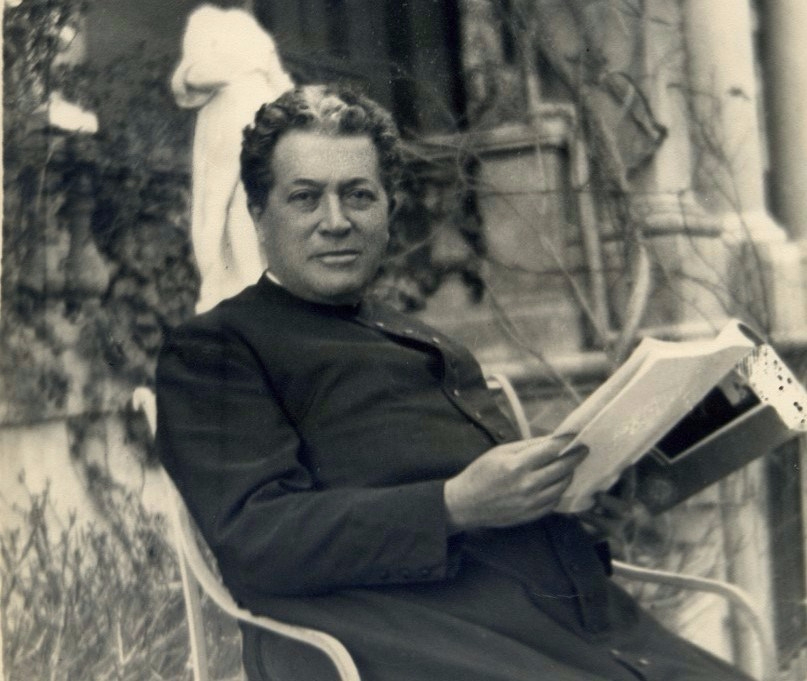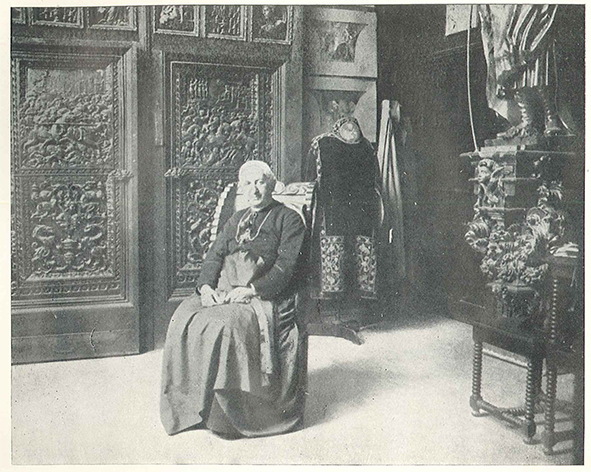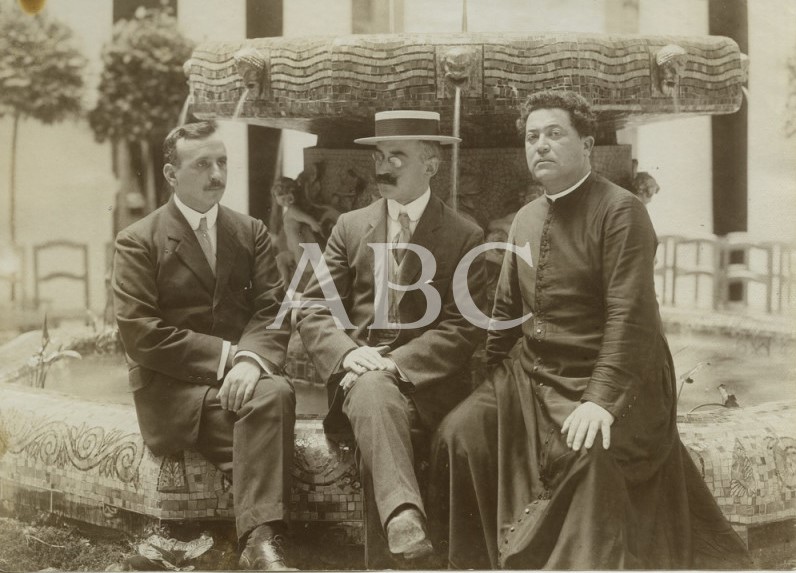
Félix Granda, reading in the garden of the Hotel de las Rosas, next to the fountain of Goya and in front of the building of the columns. Circa 1925.
On a day like today, 150 years ago, Félix Granda Buylla was born in Pola de Lena, Asturias, Spain.. He was the eldest son of Wenceslao Fernández Granda, a physician by profession, and Elvira Álvarez-Buylla Santín. Elvira was member of an enlightened family that gave rise to some of the most outstanding personalities of the Asturian intellectual and political scene of the 19th and 20th centuries.. This cultural environment, together with the one he experienced in the seminary, was undoubtedly crucial in his formation.
At that time, Bishop Ramón Martínez Vigil was Bishop of Oviedo, who brought to the Seminary the winds of change associated with the Liturgical Renewal Movement. This created a breeding ground in which music, art and Christian archeology became of great interest. In this climate, Félix Granda continued his studies until he was ordained a priest in December 1891.. This date, which marks his ordination and the beginning of his adult life, was probably also the date on which he began his professional artistic career, which, years later, would be the one that his sister Candida would indicate as the founding of the Talleres de Arte.

In the background, Félix Granda with his painter's palette, and in the foreground his sisters Cándida and María. Around 1905
Naturally, by that time he had already produced some pictorial works. There is no record that he received any formal education in this area, but he did receive was part of the so-called Artistic Colony of Muroscreated around the figure of Casto Plasencia. It was probably there that he met Cecilio Pla y Gallardo, who would count him among his most outstanding disciples.
During these years, he forged the ideas that led him to dedicate himself body and soul to the renewal of Christian art and, in time, to found his company. The decision must not have been easy; however, The Church hierarchy, which saw his proposal as a necessary good, supported him.. The support of Bishop José María de Cos y Macho, whom he met during his time at the Seminary, was especially important. Years later, this Prelate would say: "Great, above all, is the satisfaction I feel at your present triumphs, because they remind me of those days of fear and indecision when I had the good fortune to encourage you and say to you frankly: follow without hesitation, for the good of Religion, the career of the Arts, combining perfectly your vocation as a priest with your skills as an artist.."

José María Cos y Macho, at the Hotel de las Rosas, ca. 1910. On the right can be seen the sculpture of San Joaquín, then attributed to Juan de Juni, which is still preserved today in Talleres de Arte Granda.
Bishop de Cos not only encouraged him, but also gave him his first important assignments, when he was appointed Bishop of the diocese of Madrid-Alcalá in 1892. First, he painted the paintings in the chapel of the Episcopal palace in Madrid.which are still preserved today, and a new structure for the Juan de Borgoña altarpiece. (d. 1536), then installed in that chapel and today at the Almudena Cathedral.
Shortly thereafter, he intervened in the parish of Nuestra Señora del Pilar de la Guindalera, in the parish of San Esteban and in the chapel of the Sisters of the Domestic Service.. In 1899 he received recognition in his native land, receiving the gold medal of the second division of the Gijón Regional Expositionwith an altarpiece made for the Gilhou family.

The first chiseling section at the Hotel de las Rosas, circa 1910.
Family tradition has it that, in these early years, settled in a small studio on the street of Fernando III el Santo. We could say that these years are the prehistory of the Workshops, which really began to be written when around 1903, they established themselves in the Hotel de las Rosaswith the help of his sister Cándida Granda and Santiago Sampil. In this property in Chamberí, located on the left side of the old Hippodrome de la Castellana, Granda was building his company, which he called Talleres de Arte. The name, somewhat ambiguous, was nevertheless very accurate, because the buildings were like a swarm in which the different departments worked together. From an early date, up to 12 different trades were developed in the workshops.among which he always excelled in silverware and, in particular, his chiseling and embossing. Félix Granda gradually abandoned his activity as a painter, as an individual artist, and focused on his work as artistic director, in which he excelled notably.

ABC: Antonio Palacios, Sileno and Félix Granda at the Decorative Art Exhibition at the Círculo de Bellas Artes (Madrid, 1911).
In 1911, Félix Granda was awarded the Gold Medal at the Decorative Art Exhibition organized by the Círculo de Bellas Artes de Madridwhere he had presented the works of his Art Workshops. Competing in this exhibition were other recognized names such as Daniel Zuloaga, Ruiz de Luna or Vidrieras Artísticas de los Hermanos Maumejean. That year he also published a book-catalog entitled Art Workshopswhere he expounds his ideas in a chapter called "My Purpose", which begins in this eloquent way: "To make an art impregnated with the odor of Christ, saturated with memories of the past, where the biblical spirit palpitates, and that this art be alive, because it is united to the trunk of traditions, and because, being of the past, it corresponds to the needs of the present: such is my desire."
Shortly thereafter, in 1913, they will incorporate the company into a joint-stock company, Talleres de Arte S. A.The brothers Félix and Luis Herrero, brothers Manuel and Wenceslao Serra Lugo-Viña and Selina Hamilton, wife of the latter, will be an important part of the group.

Félix Granda and the team of sculptors (among them and after Granda, José Capuz) in front of the altarpiece of the Sagrado Corazón de Reina, Havana (1922).
From this moment on, the Workshops will receive important assignmentsas the decoration of San Juan el Real de Oviedo (1915) or the crowns for the Virgin of Covadonga (1922) and Guadalupe (1928). In addition to religious art, to which he dedicated his main effort, he also made civil art, of which some examples have survived to the present day, such as the diploma for Queen Victoria (1910) or the monument dedicated to Vázquez de Mella in Madrid. From these early years, his works reached foreign countries and found great acceptance in America, where some of his best works can be seen.He also worked on the altarpiece of the Jesuit church of Reina, in Havana (1922). Granda surrounded himself with excellent artists, among them José Capuz, Juan José García, Germán Gil Losilla, Julio Vicent, Maese Calvo, and a long etcetera.
The Civil War put a brake on the activity of the Workshops.. Félix Granda remained in charge of the company during most of the conflict. After the war, its activity focused on the repair and replacement of lost heritage, also collaborating with the Artistic Recovery Service.
In addition to the aforementioned awards, Félix Granda was a member of the Spanish Association of Painters and SculptorsHe was distinguished with various honors, such as honorary member of the Círculo de Bellas Artes, and honorary canon of the cathedrals of Burgos and Havana. At the end of his life, Felix Granda suffered from senile dementia, which definitively prevented his activity in 1953. He died on February 23, 1954 at the age of 86, and is buried in the Almudena cemetery in Madrid.
By: Emilia Gonzalez
____________
Bibliography:
GRANDA BUYLLA, Félix: Art workshopsBlass y Cía., Madrid, 1911.
Díaz Quirós, Gerardo: "Talleres de arte y el diseño de espacios interiores para el culto", in Fernández García, A. Mª (coord..): Interior decoration. Firms, commercial houses and design in Asturias, 1880 - 1990., Septem Ediciones, Oviedo, 2012, pp. 55 - 103.
C/ Galileo Galilei, 19.
28806, Alcalá de Henares,
Madrid. Spain
info@granda.com
(+34) 91 802 36 55

C/ Galileo Galilei, 19.
28806, Alcalá de Henares,
Madrid. Spain
info@granda.com
(+34) 91 802 36 55